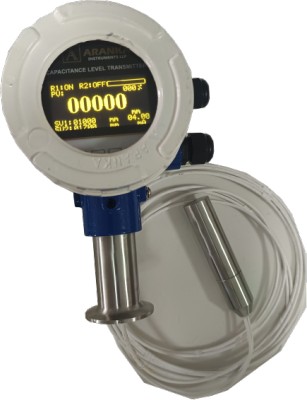

Capacitance Level Transmitter Manufacturer
Aranka Instruments LLP is a reputed Capacitance Level Transmitter Manufacturer and Supplier in Ahmedabad, providing high-accuracy instruments for continuous level measurement of liquids, slurries, and semi-solid materials. These transmitters work on the principle of capacitance variation, where an insulated probe acts as one electrode and the tank wall (or reference rod) acts as the other. As the liquid level rises, the capacitance increases; when the tank is empty, the capacitance decreases — ensuring precise level detection based on dielectric changes.
The measured capacitance is converted into a standard 4–20 mA or digital output, ensuring accurate and stable level monitoring for industrial automation. Built with robust materials and advanced signal conditioning, the Aranka Capacitance Level Transmitter delivers reliable performance even under high-temperature, high-pressure, and corrosive conditions. It is extensively used in chemical processing, water treatment, food & beverage, pharmaceutical, and oil & gas industries, offering a maintenance-free, durable, and cost-effective solution for both conductive and non-conductive liquids.
- Liquids
- Powered and granular solids
- Liquid metals at very high temperature
- Liquefied gases at very low temperature
- Corrosive materials like hydrofluoric acid
- Very high pressure industrial processes.
| Power Supply | 24VDC | |
| MEASURING RANGE | MAX. 3000MM | |
| APPLICATION | LIQUID / SOLID | |
| OPERATING TEMPERATURE | -40 ~ 150’C | |
| MAX. PRESSURE | 10 BAR | |
| ACCURACY | +/- 2% FS | |
| CONNECTION | THREAD, DIN, ANSI Flanges, Tri-Clamp | |
| PROTECTION | IP67 | |
| RESOLUTION | 1 MM | |
| ENCLOUSER | ALUMINUM | |
| ISOLATION | PTFE | |
| CONTACT PART MOC | S.S 316 | |
- Liquids
- Powered and granular solids
- Liquid metals at very high temperature
- Liquefied gases at very low temperature
- Corrosive materials like hydrofluoric acid
- Very high pressure industrial processes.
Frequently Asked Questions (FAQs)
What is a Capacitance Level Transmitter?
A capacitance level transmitter measures liquid or slurry levels by detecting changes in capacitance between a probe and the tank wall as the liquid level varies.
How does it work?
The insulated probe and tank wall act as capacitor plates. As the liquid level rises, the dielectric constant changes, increasing capacitance. This change is converted into a 4–20 mA or digital signal representing the liquid level.
What are the main advantages of a capacitance transmitter?
-
High accuracy and repeatability
-
No moving parts, low maintenance
-
Suitable for conductive and non-conductive liquids
-
Performs well in harsh environments
-
Compact, reliable, and cost-efficient
What types of media can it measure?
It can measure liquids, slurries, and powders, including corrosive or viscous materials found in industrial tanks and silos.
What are the typical output options?
Standard 4–20 mA analog output and optional RS-485 (Modbus RTU) for integration with PLC, SCADA, or DCS systems.
What factors affect the capacitance measurement?
The dielectric constant of the medium, area of the probe, and distance between electrodes directly influence the capacitance and therefore the accuracy of level detection.

